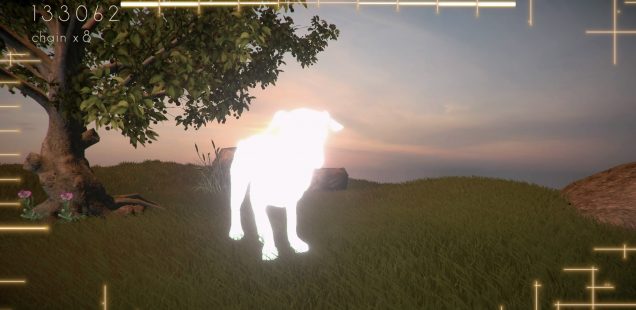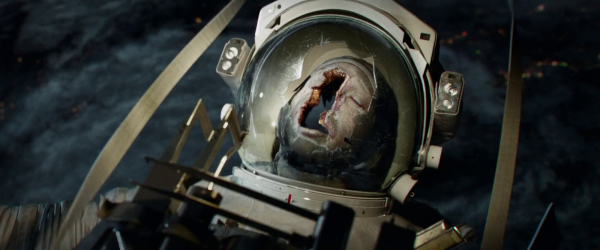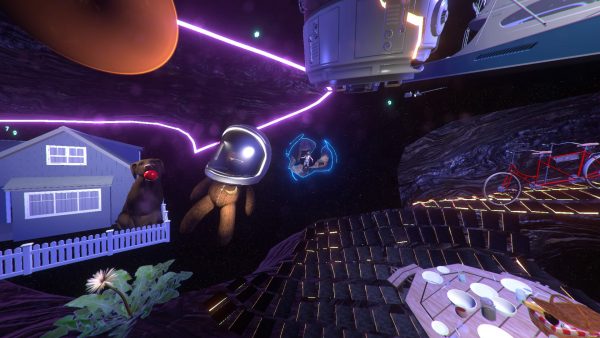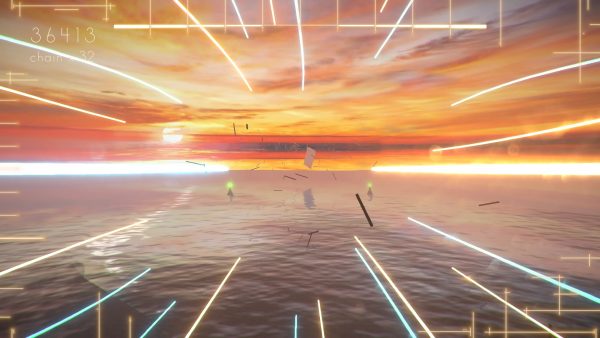
Let’s Place: Guided Meditation
Daria Kalugina picks up the pieces.
Start by finding a comfortable position, then feel how the controller rests in your hands, feel the grips on the sticks. Imagine the vast dark cosmos. There is a tiny shining dot in the blackness, moving towards a larger, asteroid-like shape. As they collide and the shape is outlined with the thin lines of light, your view flies in to have a better look. Inside the space rock, in a small cage, there is the corpse of an astronaut lost in the space, embraced by several glowing lines of light.
You are the two glowing lines, navigating through space, your objective is to collect pieces of shattered memories represented by simple shapes. The game produces a rhythmical soundscape, it shapes your movements and dictates the pace in which you collect those pieces. To succeed in gathering all pieces together you have to find the right pace and pattern. You control two glowing lines on their way forward, and your task is to catch and sometimes hold the pieces of memory. It is not an easy task to maintain your attention on the objective, navigating yourself with both sticks.
After each level is complete, you are rewarded with a piece of the narrative.
Laserlife is told through artifacts. The story does not invade the game flow, it leaves these small traces of evidence. Those objects and apparitions work as the focus points for the player, something to direct your attention to. While you traverse through the space, those associations arise on your path. There is too little time to engage with them, the images elude you, as you are completely focused on catching the pieces in time. The shards of memories that you have to collect are only assembled into larger pieces, never into the full story. You see a dog on the lawn, or a bicycle for two, a blooming dandelion, or the space shuttle. All of these are accompanied with single sentence generalized captions on the bottom of the screen, as if fitting the pieces of someone’s life into a postcard. It generously provides you with the gaps, for you to fill and utilize.
The strict pace of Laserlife’s gameplay, along with the contemplative structure of its story, gives Laserlife a dual nature. The space inhabited by the glowing lines you control is simply a decoration, if we are to view it in relation to the puzzle gameplay. Similarly to the soundscape, the space is simply another instance of rhythmic pattern to fulfill the consistency of the puzzle. It is something you don’t have the luxury to pay attention to, if you want to keep up with the game and collect all pieces of memory, as they swiftly pass you by. It’s almost detached from the narrative—just scenery.

Gravity, directed by Alfonso Cuarón, 2013
But if we turn to the perspective of the story, the cosmos and the places of memory become essential. The human lost in the emptiness of space, invoking a familiar motif of cinema. They’re a resource, who provides us with the pieces of imagery and things, with the promise that it’ll come together eventually.
This game functions as a manual for visualization: as if meditating, you summon the images out of nowhere, you navigate your self via the endless visualization of someone’s life. The imagery is abstract yet relatable. Imagine the artifacts of your home, things shared with your loved ones. Personalized narratives contained in common symbols.
Through the collection of memories we learn the astronaut’s fate. Their body becomes animated in the post-mortem spasm of recollection. The perspective of the captions, that come together with the images at the end of each level, is changing—the first part, in which we learn about their childhood, is told from first person:
I remember the world of play
Then there is a change in subject:
Do you remember the engineering path
This gradual detachment unfolds over the course of the game—the only apparent human is not the main actor, and their role is more conditional to the story, stripped from their agency they become a narrative tool, surrendering their subjectivity to someone / something else. This someone is hard to identify, as there is no one but this traveling consciousness represented with glowing lines collecting the pieces of memories scattered around the space, until it turns into this vague notion of commonality / community:
We remember your sacrifice

Laserlife tells a personal story and yet embraces the familiar narrative of this small human life stuck alone in the eternity of space for no one to discover. Working through Laserlife, you move past fear—the fate of the dead astronaut doesn’t really concern you that much—it’s flattened to an image. What does concern you though, is the path of the narrative told in between lines rushing through the screen.
A similar detachment also takes place within the realm of the game’s puzzle aspect.
First of all, to succeed in this game you must embrace the possibility of failure, which is probably true of the most games, yet in Laserlife the struggle to play is so foregrounded, and lies in the space between your own brain and vision, as opposed to the technique and mastering the scripted actions of the game.
If I choose to play Laserlife, then the settings and the images that arise during the game slip through my awareness. I let the images come and go. The story is unfolding in the distance and getting closer to it makes it harder (if not impossible) to play, as grasping the narrative and imagery will disturb the rhythm and the flow of the game.
It’s all about finding the sweet spot, that place of desynchronisation or detachment, that will allow you to move both sticks, and not miss pieces. I notice that I’m not looking at the screen, rather right through it. As if my brain falls into a trance and releases the controls, directing my attention beyond the screen, while the unseen entity keeps gathering the pieces together, I let my own mind wander, embarking on a journey of my own.

Laserlife_20190422085620
This is the place where the story of the stranded astronaut, as dramatic as it is, steps into the background and becomes a companion for your own thoughts. The game takes you through those visualisations and invites you to feel the gaps while simultaneously coping with the story you are witnessing.
There are several layers of detachment:
- You have to unsee in order to see yourself through the game.
- You have to distance yourself from the reality of the narrative—yet this happens naturally, as you have a more urgent task at hand.
- The actions you take do not correlate with the story—they are the tool to proceed or to unlock the narrative, released piece by piece. Memories become the reward of this symbolic journey. The narrative of loss reshapes the remembrance from burden to a treasure.
- The pieces of the story are themselves filled with gaps and empty spaces. Placed so far apart, they only comprise the skeleton of a story and guide you to fill in the blanks with ungoverned storytelling, completely on your terms.
Human subjectivity pierces through space via the traces and artifacts of life, and simultaneously dissolves into glowing lines and musical rhythm. This detachment of the physical senses goes hand in hand with emotional detachment. Does space feel compassion? Does it provide companionship?
Daria Kalugina lives in Moscow. Sometimes she works in artistic education, and dreams of building fictional worlds for learning.